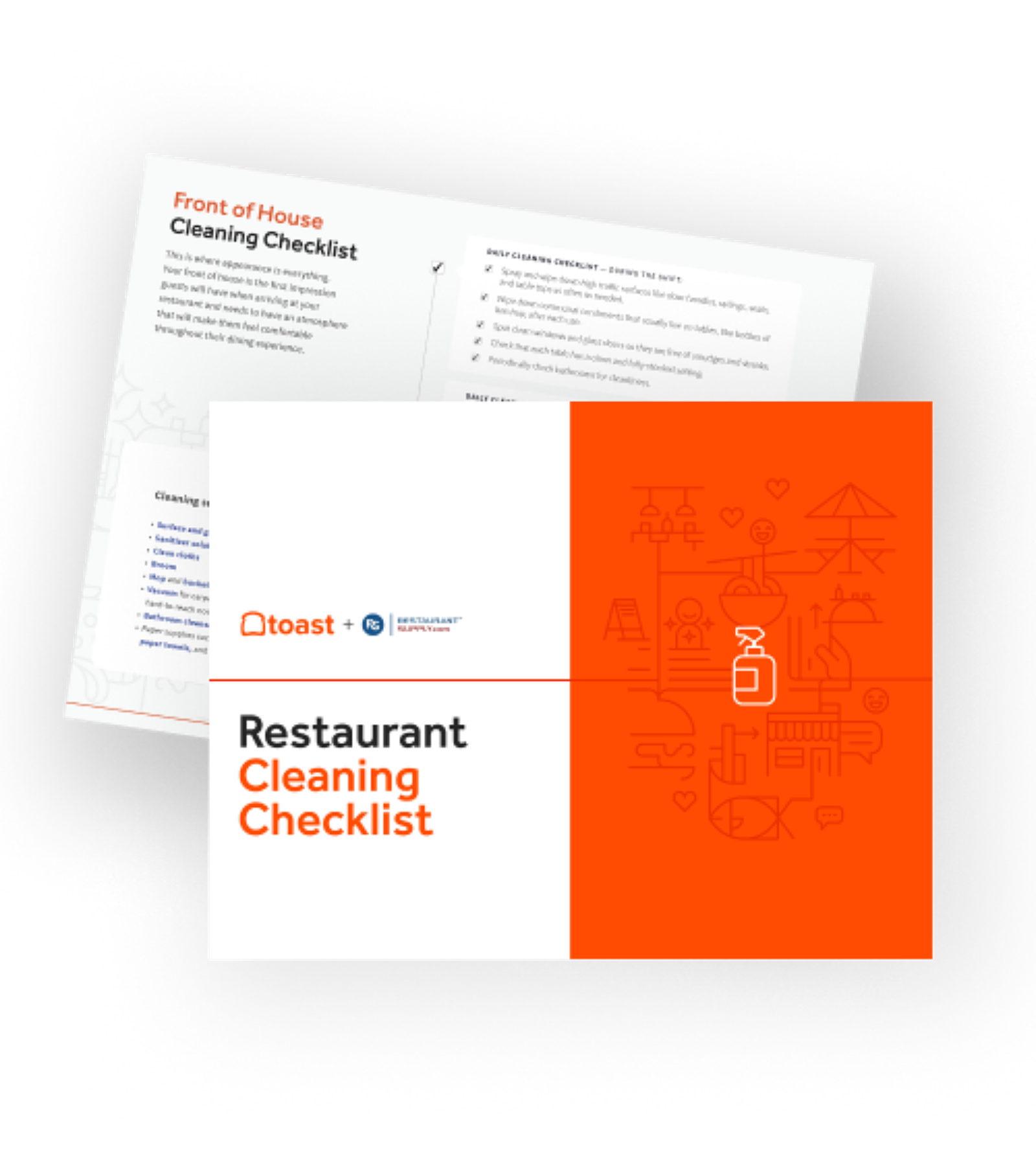
Deli Cleaning Checklist Template: How to Clean a Deli
Learn how to keep your deli in tip-top shape with the ultimate deli cleaning checklist, from safe food handling practices to cleaning supply lists.
Grace JidounAuthor


Restaurant Cleaning Checklist
Download the Restaurant Cleaning Checklist, created in partnership with RestaurantSupply.com, to keep track of the cleaning tasks that need to be completed in your restaurant.
Get free downloadDeli Cleaning Checklist
It’s impossible to say the word “deli” without thinking of pastrami sandwiches piled high on rye, steaming bowls of homemade soup, and waitresses that call you “honey.” But what makes a deli truly great? It’s more than just delicious food, a welcoming atmosphere, and snappy service. Cleanliness is an essential component of success in any restaurant, large or small.
Most people would agree that any signs of an unclean eating environment or even a letter grade below an “A” can kill an appetite. But the reality is that it may not be so apparent that a deli or restaurant isn’t adhering to adequate health standards. A simple mistake of cleaning up a spill with a used towel without proper disinfectant can lead to cross-contamination or, worse, the spread of bacteria and viruses. While cleaning may seem like a no-brainer, it’s surprisingly easy to mess up.
Toast data shows that a whopping 45% of diners go out to eat multiple times a week. According to a 2021 survey by Technomic, more than 75% of those polled said that a food service establishment’s cleaning policies would impact their intent to visit. Sure, you can hire a professional cleaning service, but you and your employees still need to be well-versed in all aspects of cleaning.
“A culture of food safety is the most important way to protect your business, and the message should come from the top down,” says Larry Lynch, Senior Vice President for Health, Safety, and Regulatory Services at the National Restaurant Association. “It’s up to the owners and senior management to drive the culture so that all employees understand the core concept of food safety,” he adds.
Consider this article your ultimate deli cleaning checklist. It’s a comprehensive guide to keeping your restaurant spic-and-span.
Front of House
The condition of your front of the house is the primary signal to customers that sanitation is taken seriously. Research from Harvard Business Review suggests that, on average, a consumer will form an impression of a retail interaction within 7 seconds. It’s essential to make sure that your public-facing areas are sparkling clean.
Cleaning Supplies Needed
Surface and glass spray cleaners
Disinfectants (food-grade cleaning solution or bleach)
High-quality cleaning rags
Industrial brooms
Cleaning gloves
Mop and bucket of hot soapy water
“Wet Floor” sign
Vacuum for carpeted areas
Bathroom cleaning supplies such as bleach, toilet bowl cleaner, and scrub brush
Paper supplies such as toilet paper and paper towels
From wiping up crumbs on tables to mopping the floor, a daily checklist will help you keep the public spaces of your deli up to the highest standards.
During The Shift
Tabletops should be cleaned in between customers with a fresh towel, or microfiber wipe and a food-grade disinfectant (pushing around crumbs on the table doesn’t count).
Wipe down and spray all communal, high-traffic surfaces like chairs and counters — don’t forget door handles, light switches, and railings.
Clean any stainless-steel surfaces that look dirty.
Clean any glass surfaces that look dirty. Nothing is more off-putting than a deli display case with smudgy fingerprints all over it.
Check the bathrooms for cleanliness (we can’t stress this enough). A grimy mirror or empty soap dispenser will make customers wonder if this lax attention extends to other areas of your deli. Essentials include checking the floor for toilet paper and trash, flushing the toilets (if someone forgot – it happens), wiping down counters and sinks, and refilling paper towels and toilet paper.
Empty full garbage cans throughout the day in the public areas, including the bathroom.
When Closing Out
Deep clean the high-traffic areas you wiped down earlier in your shift: tabletops, chairs, countertops, and more.
Sweep the floors and mop them with disinfectant.
Thoroughly clean the bathrooms, including mopping the floors and cleaning sinks, mirrors, and countertops.
Using a clean towel, wipe down any condiment shakers and refill condiment packets.
Replenish the serving ware, including forks and napkins.
Vacuum up crumbs, dirt, and debris from any carpeted areas.
Replenish the supply of plastic gloves for the next shift.
Weekly
Deep clean the toilets and wipe down each stall door in the bathrooms.
Vacuum or sweep in the hard-to-reach areas, checking under tables and in corners.
Spray and clean all the glass windows, doors, and mirrors.
Water and trim the dead leaves off of plants.
Polish and clean any stainless-steel areas.
Scrub any spills or splatters off the walls.
Disinfect all trash can exteriors and interiors.
Monthly
- Dust all fixtures, including things that are high up in your deli, like lights, fans, exposed duct work, and the tops of tall furniture or appliances.
Wash entry mats with plain soap and water to remove accumulated dirt and footprints.
Clean your baseboards of dirty build-up and scuff marks.
Check carpets, curtains, booths, and other upholstered items for damage and repair and clean them as needed.
Do a thorough deep cleaning of the tables and chairs in the eating area, which means wiping down legs, back, and underneath.
Back of the House
While the front-of-the-house is your customer’s first impression, the back-of-the-house is where things get real. Without proper sanitation of the equipment and prep areas, your customers could be unknowingly exposed to dangerous pathogens. Following our deli cleaning checklist will help prevent cross-contamination — one of the most cited food service health code violations. Cleaning as you go is essential, but some things can be done at the end of the shift, the end of the week, or monthly. Here, we itemize the tasks.
Cleaning Supplies Needed
Disinfectants (food-grade cleaning solution)
Dishwashing soap
Degreasing cleaner or vinegar for fryers and ovens
Dedicated cleaner for your ice machine
Abrasive tools and scrub pads to clean pots and pans, including coarse brushes and steel wool
Non-abrasive tools to remove food and oil, including cloths, sponges, and soft brushes
High-quality dry-cleaning rags
Disposable disinfecting wipes
Mop and bucket
Broom and dustpan
Disposable gloves
Prep Station
During the Shift
Wipe down the prep areas throughout the day.
Wipe down and clean cutting boards and switch them out when necessary.
Clean cutting knives, slicers, and other food prep tools to remove food buildup and bacteria as needed.
Ferry dirty pots and pans to the dish pit as needed.
Switch out the cleaning rags during the day to ensure there’s always a fresh supply available.
Empty the trash throughout your shift.
When Closing Out
Wash and sanitize all surfaces, including prep tables and cutting boards.
Cover all food with plastic wrap and write the date before storing it in the fridge.
Clean and sanitize the microwave (inside and out)
Throw all laundry, including cleaning rags, napkins, and aprons, into a bag for a restaurant laundry service to pick up.
Empty and disinfect the trash cans.
Sanitize and clean out the ice bin
Sweep and mop the floor, including washing the floor mats.
Restaurant Reopening Checklist
Learn how to approach reopening your restaurant during COVID-19 with this 78-item checklist.

The Line
During the shift
Wipe down the cooking line frequently throughout the shift.
Clean up spills and puddles immediately.
Keep food bins covered when not in use.
Brush the grill between cooking different types of meat and seafood.
Make sure ingredients are stored at the proper temperatures. For instance, according to the Centers for Disease Control (CDC), foods like poultry, soft cheese, eggs, seafood, and sprouts must be refrigerated at 40 degrees or colder to minimize the risk of salmonella and other bacteria.
When closing out
Clean the fridges and freezers, including the shelves and the gaskets — and don’t forget to check underneath for crumbs.
Move any small cooking equipment or countertop equipment and clean under/behind it.
If you have deep fryers change out the oil every day (and at least once a week).
If you have a steam table, empty the water wells daily so bacteria doesn’t grow.
Change all foil linings on your grill, range, and flattop.
The Dish Pit
During the Shift
Empty the dishwasher from las night's run
Put away all clean dishware and tools in their proper places.
Wash dishes throughout the day.
Clean up puddles as soon as possible.
Restock cleaning solutions if you’re running low.
When Closing Out
Make sure all the dishware, pots, and pans from the day are cleaned in the dishwasher or thoroughly hand scrubbed.
Handwash any gear that cannot be run through the dishwasher.
Return everything to the proper places for the next shift.
Place all remaining restaurant kitchen tools, containers, and gear in the dishwasher and run overnight.
Disinfect the three-compartment sink.
Thoroughly clean the dish pit.
Take out the trash and recycling at the end of the night.
Weekly
Prep Station
Wipe down all shelving in the dry goods area.
Dust and sanitize all under-the-counter shelving areas and cabinets, including wiping down the outside of cabinets.
Empty the display case and thoroughly clean it with a food-grade cleaner.
Move anything with wheels and clean behind it.
Scrub the floors and get all the hard-to-reach places.
The Line
Sanitize and wipe all coolers and refrigerators, to remove any food scraps or mold.
Move any smaller equipment like barista machines, microwaves, etc., and clean under/behind them.
Clean the inside of all ovens, steamers, and microwaves.
Change out the oil in the deep fryer (if you’re not doing this daily).
Wipe down vents and exhaust hoods, ensuring they are dust and grease free.
The Dish Pit
Thoroughly sanitize the dishwasher and sinks - they should look almost brand new.
Inspect all drains for buildup, cleaning if needed.
Check for signs of pests, mold, and mildew.
Reorganize the dishes if needed.
Opening a Sandwich Shop Checklist
So many things go into opening a Sandwich Shop. Use this free PDF checklist to set your new restaurant up for success.

Monthly
Prep Station
Clean any filtration systems and deep clean every spout and water tap.
Perform a deep cleaning of your ice machine to remove any bacteria. Take out all the ice before cleaning with a sanitizing mixture, check the drain lines, and ensure they are all clean.
Sharpen all knives in the kitchen and replace any broken tools and equipment.
Check your first aid supplies and replace anything running low, including bandages, eye-washing solutions, burn gels, ice packs, gauze, tensor bandages, and more.
Check the fire extinguishers to ensure they are up to date and not damaged.
The Line
Ensure all ovens and cooking equipment have been calibrated up to code and properly functioning.
Clean the exhaust hood and filters, and check your exhaust fan to make sure it’s working properly and free of grease.
Deep clean your freezers and coolers.
Scrub and wash all the interior walls of the cooking area/kitchen
If you have a deep fryer, it should be thoroughly cleaned.
Inspect the grease trap and clean it if needed (or hire a professional cleaner).
Perform a safety walk-through checking the quality of the floor mats and any other tripping/slipping hazards.
The Dish Pit
Deep clean the floor, walls, and sinks around the dish pit.
Check your dishwasher and sink areas for limescale buildup and de-lime if necessary.
Inspect all drains for buildup and clean them as necessary.
Clean the food trap or filter on your dishwasher (this could be weekly, depending on how many loads you do a day).
It may seem that we’ve covered all the ways you can keep your deli sparkling clean, but there are a few additional considerations — and they’re big. Here we share strategies for preventing food-borne illness, complying with local health codes, and above all else, ensuring a wonderful experience for your guests.
Best Practice #1: Focus on Preventing Food-borne Illness.
Food poisoning is a blanket term for any form of illness that results from eating expired or contaminated food. Food can become contaminated with bacteria such as E. coli, viruses such as hepatitis, and even some forms of parasites.
Who can forget the 2019 outbreak at a Michelin-starred restaurant in Spain, where 29 diners became ill and one, sadly, died? While that’s an extreme case, no eatery — from fine dining to street carts — can underestimate the importance of combating food poisoning. Thankfully, it’s preventable if you follow some simple steps.
- All staff must wash their hands for 20 seconds with soap and warm water (that’s two “Happy Birthdays”) throughout the day.
- Keep food at safe temperatures. According to Larry Lynch of the National Restaurant Association, this is the most challenging area of the cleaning process for restaurants. “What if your thermometer is off by a little bit? It’s crucial to have the proper equipment to identify if the temperature is too high or too low. Also, you’ll have to stay on top of the science around food safety because recommendations on safe temperatures do change,” he says. The danger zone (when bacteria start to grow) is above 41 degrees and below 140 degrees Fahrenheit.
- Take measures to prevent cross-contamination. Food safety must become a habit. “Practice every day so you understand the “why”. When employees understand the “why,” it becomes a lot easier as they’re going to naturally wipe down the counters and tables with the right kind of solution,” Lynch says.
- Don’t allow sneezing, coughing, or otherwise sick staff to work.
Store all food items properly.
Best Practice #2: Check the Health Department Guidelines
The most feared person in the restaurant world is not the food critic or the landlord but the health inspector. Health inspectors show up unannounced, record violations, and in extreme cases, can shut your deli down. Do not wait for a poor letter grade of “B” or “C” to appear in your window before taking health inspections seriously. Even though some major cities like Los Angeles have scrapped visible letter grades, the findings are still posted in an online database. Here are a few tips for navigating the health department:
- Be proactive. Check with your city’s health department or whoever conducts health inspections to ask for a complete list of what an inspector is looking for.
Change your outlook: Think of the health department standards as a guide to inform you (instead of an after-the-fact punishment).
Once you’ve done your research, use the health department standards as the foundation of your food safety and cleaning processes.
Research accredited food handler training programs such as ServSafe, which offers an interactive map of regulatory requirements in all 50 states.
Consider running regular test inspections to prepare your staff for the real thing.
Most health departments will allow you to comply with their findings. Take advantage of their resources and cooperate fully with authorities to learn what systems need to be in place.
Best Practice #3: Prevent Pests
A single cockroach spotted by a customer can spell disaster for your restaurant. Here are the basics for keeping your deli pest free:
Wipe up food residue quickly.
Always clean equipment after use.
Don’t let food-contact surfaces get dirty and greasy.
Store food in airtight containers.
Move trash bags to the dumpster rather than letting them sit around the restaurant.
Capture stray fruit flies with a small cup of soap mixed with tequila or apple cider vinegar.
Repair or replace any cracks, crevices, or damaged tiles in your deli, as pests hide in these places.
Call a professional pest control company if you see clear signs of an infestation, like roach or rodent droppings, shredded cardboard, small piles of dirt (from ants), or flying insects. Unusual odors or sounds of scratching behind the wall are also red flags.
Best Practice #4: Train Staff to Create a Culture of Food Safety
You could have the best intentions in the world, but if your staff is not entirely with the program, it doesn’t matter. From the butcher to the cashier, ensuring every employee is trained and educated in proper hygiene, food safety, and cleanliness is critical to a safe and sanitary dining experience. Here are some tips to consider:
Training is an ongoing endeavor and not one-and-done. You’ll need to follow up with your staff to ensure everyone complies with the system in place.
Post reminders about cleaning procedures in strategic places, such as above the sink or near specific machines and equipment.
Regularly share training videos with restaurant cleaning tips via email.
Put on your health department hat and spot-check your staff like an inspector would.
Publicly acknowledge team members doing a good job so they inspire others.
Best Practice #5: Deliver an Enjoyable Experience for Guests
Put yourself in your customers' shoes and imagine what it’s like to walk into your deli for the first time. Is there dust on the floor? Stains on the wall? Even the smallest oversights can make customers feel uncomfortable. Post-pandemic, people are especially attuned to cleanliness and will not hesitate to ban your deli over a strand of hair in the food. Here are strategies for making an excellent first impression.
Audit your deli’s cleanliness by having a staff member have a test meal. From the moment they walk through the doors until they finish their meal, have them record any aspects of their dining experience that need attention.
If an employee looks disheveled or unkempt, that can indicate an oversight on the part of management and a lack of caring on the part of the worker. We’re talking about bad hygiene, including no gloves or hair coverings (not tattoos and piercings).
Don’t forget to take a fresh look at the exterior of your deli. Are the trash cans overflowing? Is the awning or sign falling down? Is the paint chipping? If the answer is yes to any of these questions, your customers may pass you up for a restaurant down the street.
When you first dreamed of opening a deli, you probably didn’t think of scrub brushes and disinfectants. But cleanliness is a key component to your success. Ideally, you want to get in front of issues instead of reacting after the fact. Our guide may not magically erase all problems, but it will help you run a more efficient, cleaner, and enjoyable business.
Is this article helpful?
DISCLAIMER: This information is provided for general informational purposes only, and publication does not constitute an endorsement. Toast does not warrant the accuracy or completeness of any information, text, graphics, links, or other items contained within this content. Toast does not guarantee you will achieve any specific results if you follow any advice herein. It may be advisable for you to consult with a professional such as a lawyer, accountant, or business advisor for advice specific to your situation.
Read More
Subscribe to On the Line
Sign up to get industry intel, advice, tools, and honest takes from real people tackling their restaurants’ greatest challenges.



